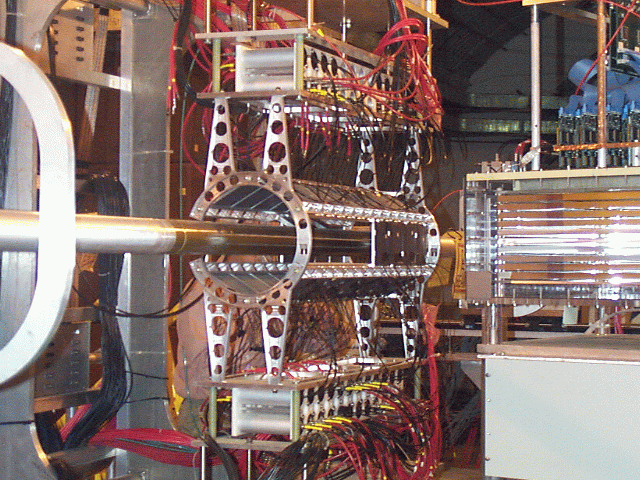Description of the scintillator tiles
The outer layer of the Centrality detector consists of an array that can accomodate a total of 48 scintillator tiles arranged in six ladders each with eight tiles. The ladders are located along the beam line making a hexagonal cross section. The figure below shows the tile arrangement at the begining of the RHIC 2000 run (38 tiles). After the so called "silicon installation" two vertical tiles facing TPM1 were removed.

The scintillator tiles are 5 mm thick and are squares 12 X 12 cm. A 2mm deep and 1.2 mm wide groove was machined along the edge of the tile. After machining, the grooves were cleaned with sand paper and its inner surfaces were left unpolished.
Two turns of 0.83 mm diameter Kuraray Y11 multiclad wave length shifter fiber are wound in the groove. The tiles are then wrapped with white Bond paper and black Tedlar foil. The optical fibers out of the scintillator are 75 cm long and are covered with a balck light tight jacket.
The scintillating material of the tiles is BICRON BC404A
The coupling of the fibers to the PMT is done with black Delrin disks with same diameter as the PMT assembly. On each disk two hole are drilled, one side of the hole has slightly bigger diameter than the fiber and the outer side has the diameter of the jacket. The fibers are inserted in the holes and the jackets and glued with black RTV. Once the RTV is hard, the fibers are cut such that approximately 2 mm extend beyond the Delrin disk. This end of the fibers is then ground and polished. One drops of optical grade epoxy (TRA-CON 2114) are applied over each fiber and the assembly is glued to the window of the PMT. Additional epoxy was applied over the black RTV to secure the fibers in place.
The photomultipliers used for this detector are Hamamatsu H3178-61 assemblies. Based on the 1.5" diameter R580-17 green enhanced photocathode.
All connections to the tiles and its readout are decribed in: cable layout